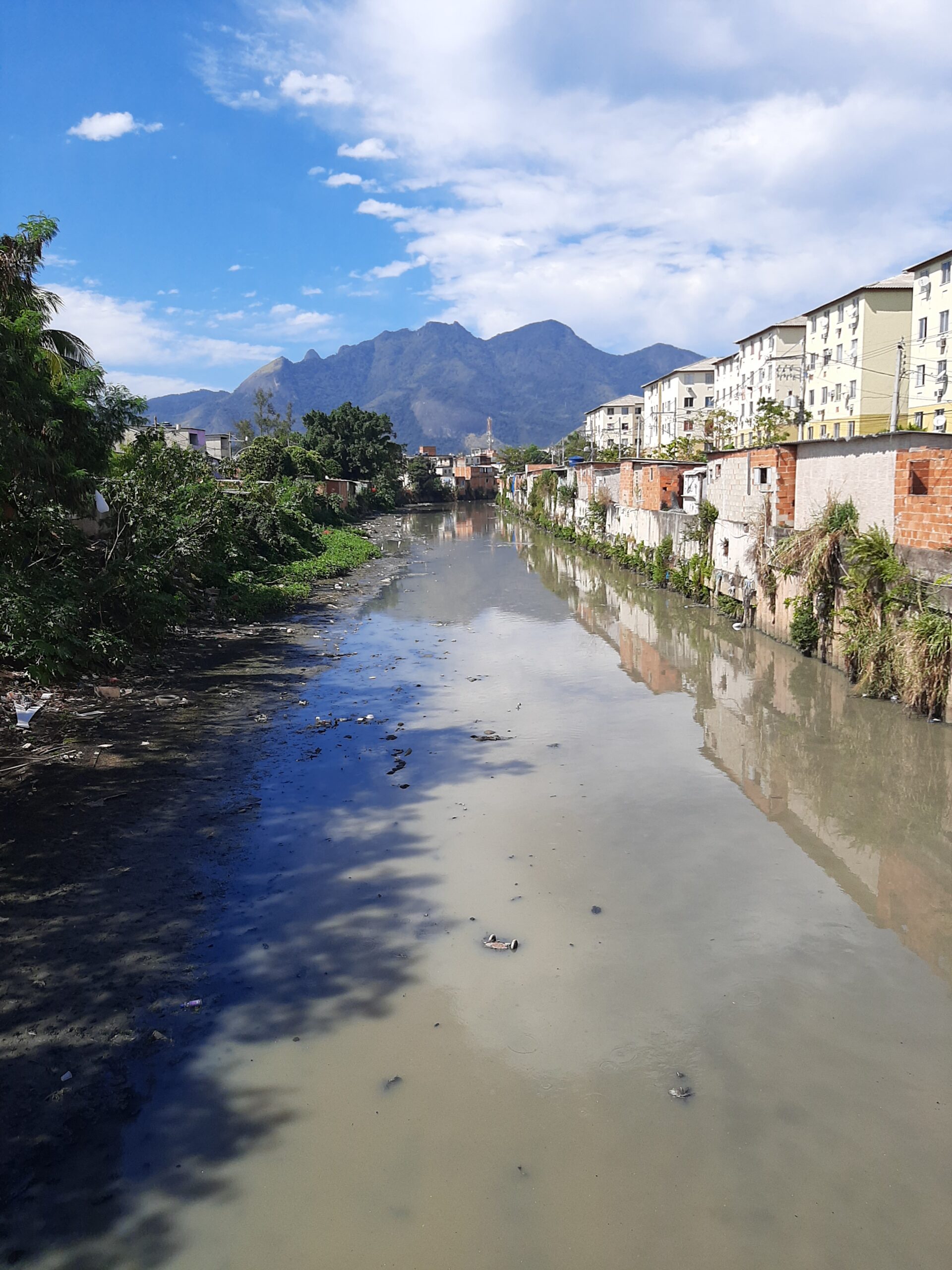
Clique aqui para Português
This is the final in a series of articles on water justice in the favelas resulting from the course “Climate Justice in Community Journalism: From Pitching to Writing.” The course, conducted by the RioOnWatch team in collaboration with the Sustainable Favela Network (SFN)* Youth Working Group took place between July and September 2023. It is also part of a series created in partnership with the Behner Stiefel Center for Brazilian Studies at San Diego State University, to produce articles for the Digital Brazil Project on environmental justice in the favelas for RioOnWatch.
Floods and Environmental Racism in the History of City of God
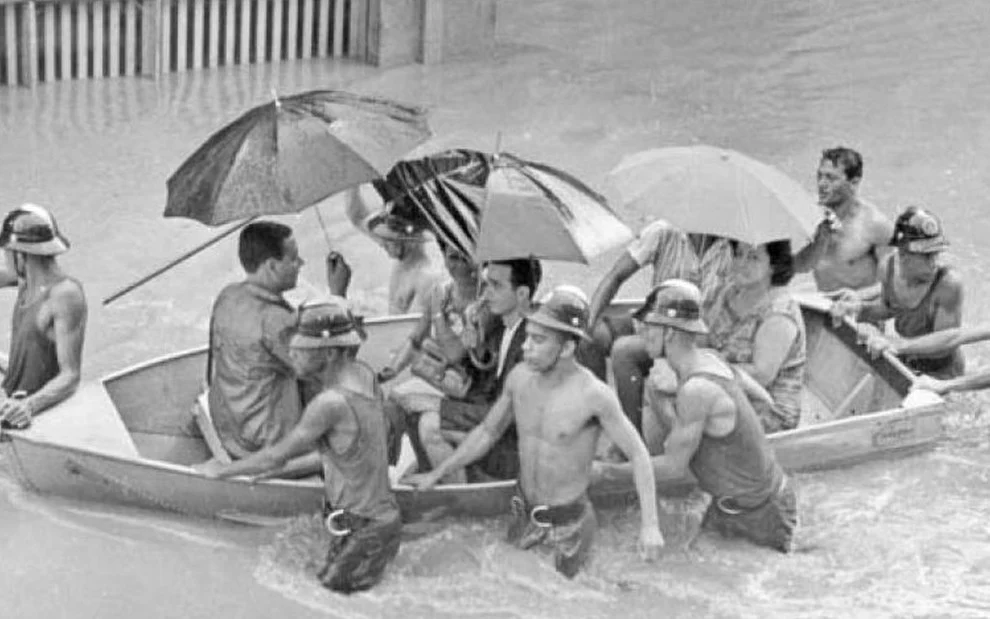
The first flood that marked the history of City of God (CDD), in the West Zone of Rio de Janeiro, occurred in 1966, affecting the entire city. The outcome was the sudden growth of the new community as it received those impacted by floods and landslides in other favelas. In our roots, we carry the memory of being the result of the removal of people from other favelas to the public housing complex initially established in City of God, whose founding was accelerated and justified to house these people in 1966.
However, this would not be the only flood to shape the territory’s history. City of God and its surrounding region of Jacarepaguá—part of Rio’s Planning Area 4 (AP4)—are prone to flooding. Bounded by the Pedra Branca Massif, Tijuca Massif and the Atlantic Ocean, with an extensive network of sub-watersheds, City of God is located in the Rio Grande floodplain. This implies that since its original construction by municipal authorities, a portion of a public housing complex was vulnerable to flooding.
Three decades later, the 1996 flood was the largest in the favela’s history. It showed that despite being a regional characteristic, the suffering and harm caused would not be evenly distributed between Jacarepaguá, City of God, and Barra da Tijuca. The event resulted in 53 official deaths and over 2,000 displaced in City of God.
We began to interact differently with the environment. People remember moments when, as children, they were placed on bunk beds, benches or walls to avoid contact with the water. Adults were worried about losing the material objects they had worked so hard to buy, but the main fear was losing their children, washed away by the force of the water or afflicted by diseases resulting from contamination by dirty water.
Gradually, stories shifted from those of cooling off in the rivers, the memories of playing in the water and along its banks, and the food security that the waters provided. Little by little, conversations began to describe the river as a source of fear and death. It instills a constant sense of vulnerability, alleviated only by the support network the neighborhood provides in times of emergency. It is the neighbors who help the affected, assist in house clean-ups, fight for the right to dignified housing, and strive to preserve the memory of those victimized in the devastated areas of the favela.
Marcia Esteves, former resident and community organizer in City of God, who served as a leader in the research course on Water and Energy Justice in the Favelas, regrets that her memories of the rivers of City of God are limited to the floods of 1996.
“I think it’s important to address the memories. Many do not know that the river was once a place for fishing and playing. I think it develops a different perspective on the part of many people who are unaware of the local history.” — Marcia Esteves
The sorrow of experiencing a flood—and the loss of clothes, food, furniture, appliances, documents and records of memories (photographs and letters)—changes the way we relate to rivers, rain and ourselves. Fear, triggered by such traumatic memories, gives rise to what is now termed climate anxiety or eco-anxiety. It manifests in several ways, such as difficulty sleeping during strong storms, regardless of the person’s physical exaustion. This is a topic that is increasingly explored by scholars in the health field.
In the dynamics of environmental racism, it is common to lay blame on residents for tragedies. In scientific articles that address flooding or pollution of favela rivers, the population is often deemed responsible. Frequently, this discourse is incorporated into conversations, even by residents themselves, without an in-depth critical assessment of the actual circumstances.
An example of this logic was exposed by the collective Building Together, active in City of God. In 2020, the collective published the results of a community survey that revealed only 52.9% have access to solid waste collection three to four days a week. For 33.3% of those interviewed, collection occurs once or twice a week; for 6.7%, less than once a week, and for 7.2%, the collection service does not reach their location. It is necessary to challenge the narrative that everything in the favela is ugly and dirty because of residents when the main problem is State negligence.
Alfazendo and the Importance of Community Bases
In City of God, the Eco Network project leads educational actions through a participatory methodology, aimed at students from the area’s municipal schools, which in 2022 and 2023 had the generating theme “Meeting of the Waters.” Its main objective is to awaken different perceptions and careful practices towards the environment and the favela’s rivers. Eco Network, created in 2011, is a social technology recognized by the United Nations (UN), the result of years of socio-environmental struggle by City of God’s Alfazendo Group alongside social movements through the Community Network for Socio-Environmental Development.
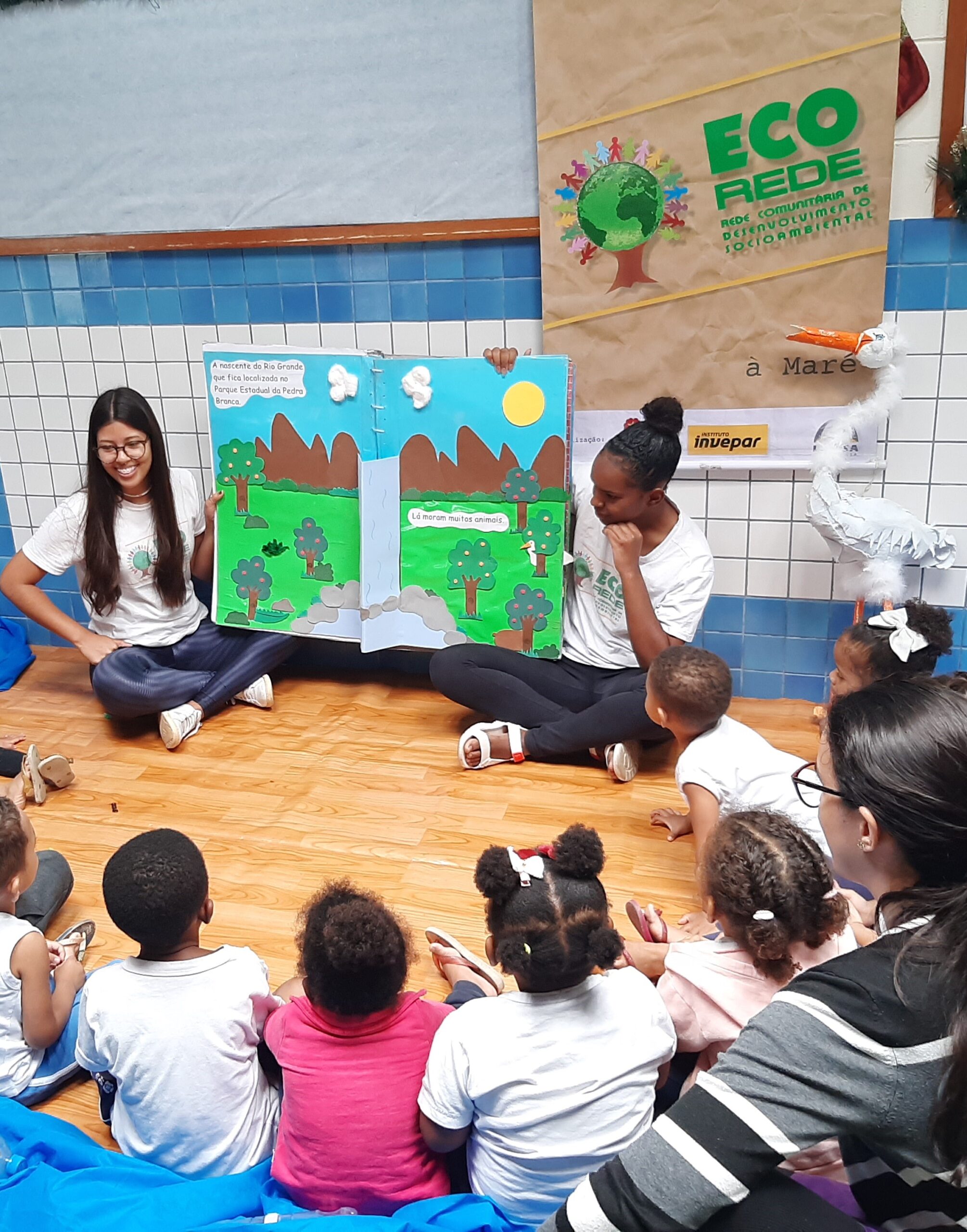
The Eco Network project aims to build the identity of youth in the area as educators. The actions involve strengthening their identity as favela residents and fostering a sense of belonging to the territory. The environment is created based on the perceptions of traditional peoples, embracing the idea that Nature has inherent rights, and recognizing that everything around us is Nature, including the forms of relationships that begin in the womb. Participants have the opportunity to view the favela with a lens of affection and care. It offers a possibility to study with, from and for City of God and not just about it.
Alfazendo has a long history of fostering critical education in the community. Since its founding in 1998, the organization introduced the first Preparatory Course for Blacks and the Needy (PVNC) in the area, in addition to literacy classes for youth and adults. The list of actions includes political advocacy, an education forum, Socio-Environmental Education Days, Favela Youth Festivals, film clubs, and more. Operating since 2011, Eco Network was replicated in the favela of Timbau, in Rio’s North Zone favelas of Complexo da Maré, by another community partner, the Center for Studies and Solidarity Actions of Maré (CEASM).
Eco Network is a comprehensive and integrated initiative that encompasses ongoing training for youth and adults, engendering employment and income opportunities. It includes a network to empower waste pickers, a point for cooperative recycling, socio-environmental education workshops, training for teachers, educators, and professionals in public schools, as well as the implementation of socio-educational structures such as sensory spaces, sustainable toy libraries, and educational gardens. These actions are developed following the participatory methodology of educator Paulo Freire, empowering learners with knowledge generated through horizontal dialogue on generating themes.
In its first year, the Eco Network team created the mini-doc “The Rio Grande in City of God”:
New Perspectives on Our Rivers
“You used to be able to fish not only in Rio Grande, but in all the rivers of City of God. When we were kids, we used to catch frogs with a bucket on the banks, and the elders made broth for the children. We gathered pumpkin sprouts. The banks were full of plants and herbs.” — Iara Oliveira
The source of the Rio Grande is located in the Pedra Branca State Park and crosses City of God. Long-time residents, such as Iara Oliveira, born in the community in its founding year, 1966, highlight the social importance, natural wealth, and many uses that local rivers had decades ago.
Even today, in the section within the Pedra Branca State Park, the waters of the Rio Grande are clean. In this stretch, the river serves as a point of extraction for the population’s water supply. However, along the way to City of God, it receives domestic and industrial sewage. Furthermore, like many rivers in urban centers, some of its sections are canalized, leading to a loss of its identity as a river.
In City of God, the Rio Grande is completely visible and uncovered. In some sections, its banks are occupied by buildings, but it is still a central and reference element for the favela’s sub-areas of Tangará, Karatê, Treze, Predinhos and Tijolinho. The Estiva and Banca da Velha rivers, on the other hand, are not labeled on the maps we had access to.
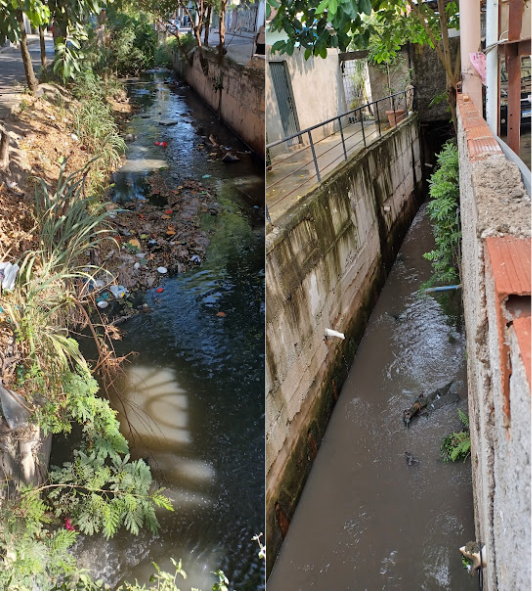
Measuring 1.4 km, the Estiva River flows through areas known as AP2 and Treze until it merges with the Rio Grande. On the outskirts of the favela, it is obscured by constructions, making it impossible to trace its entire course. In contrast, the Banca da Velha River, with a length of approximately 4.3 km, passes through Capenha, Pantanal 2, Pantanal 1, and AP until it reaches Tijolinhos. Beneath the Yellow Line expressway, it meets the Rio Grande and is then named Arroio Fundo.
In August 2022, the Regional Education Coordination (CRE) launched the This River is Mine program, a partnership between private water utility Águas do Rio and the non-profit organization planetapontocom. Within the pedagogical project, schools were tasked with developing activities to raise awareness about the condition, importance, and recovery of a river close to their school. The generating theme “Meeting of the Waters” and the work already undertaken by the Alfazendo Group over 12 years within the Eco Network made it easier for schools to develop the activity.
In the schools of City of God, this realization was challenging for educators. They faced difficulties in incorporating an active search for information about the region’s rivers into their routines. The teachers noticed that there is a lack of information about the territory’s rivers, which have their identity reduced to sewage ditches.
“When I saw that the Eco Network project would focus on the ‘Meeting of the Waters,’ I loved it. My school team loved it too because it would be in line with everything we [had worked on during the year]… It’s slow work… little by little, trying to change habits and customs that people already have. People already have the habit of not taking care of the river, of not seeing the river as something necessary.” — Tathiany Sampaio, pedagogical coordinator at Augusto Magne Municipal School and resident of City of God
Despite being a resident, Sampaio confessed that she had never delved deeply into the rivers in her favela and the social dynamics around them. It became clear to her how important it is to keep our relationship with rivers alive. Maria Eduarda Silva, a resident of City of God and socio-environmental promotion agent at Eco Network, shared a similar journey and expressed the project’s importance to her.
“When I joined Eco Network, that’s when I really looked at rivers! I looked with importance and saw how damaged those rivers are and how much Eco Network fights to improve them… It’s important [to tell] the stories of the rivers and know their sources.” — Maria Eduarda Silva
Meeting of the Waters: Eco Network in City of God Schools
The socio-environmental education workshops were Eco Network’s main activity in 2022 and 2023, designed around the generating theme “Meeting of the Waters.” Through specially created pedagogical materials, orality and affective educational practices, knowledge about rivers and local nature is being kept alive. The development of these initiatives, built collaboratively and from the ground up, strengthens the identity of the favela alongside its residents, promoting a sense of belonging and community.
Over the course of a year, the project carried out 203 socio-environmental education workshops in 21 school units, based on the book The Path of Waters: The Rio Grande and the cooperative game Meeting of the Waters. The program reached 5,962 students ranging from preschool to middle school.
The book tells the story of the Rio Grande in a playful way, providing children with an interactive experience based on their own lives and observations. It introduces characters like the alligator, capybara, and heron—animals that still inhabit our rivers in City of God. The story includes the representation of a river that is full of solid waste, and children are invited to help clean the animals’ habitat. From this, they learn that we can give new meaning to waste, as they are taught how to transform it into toys, for example. At the end of the activity, the animals in the book return to the river, which is now clean thanks to the children’s efforts. For elementary and middle school students, a cooperative board game named “Meeting of the Waters” was designed and crafted. Set along the Grande, Banca da Velha, and Estiva rivers, the game also incorporates the presence of local fauna.
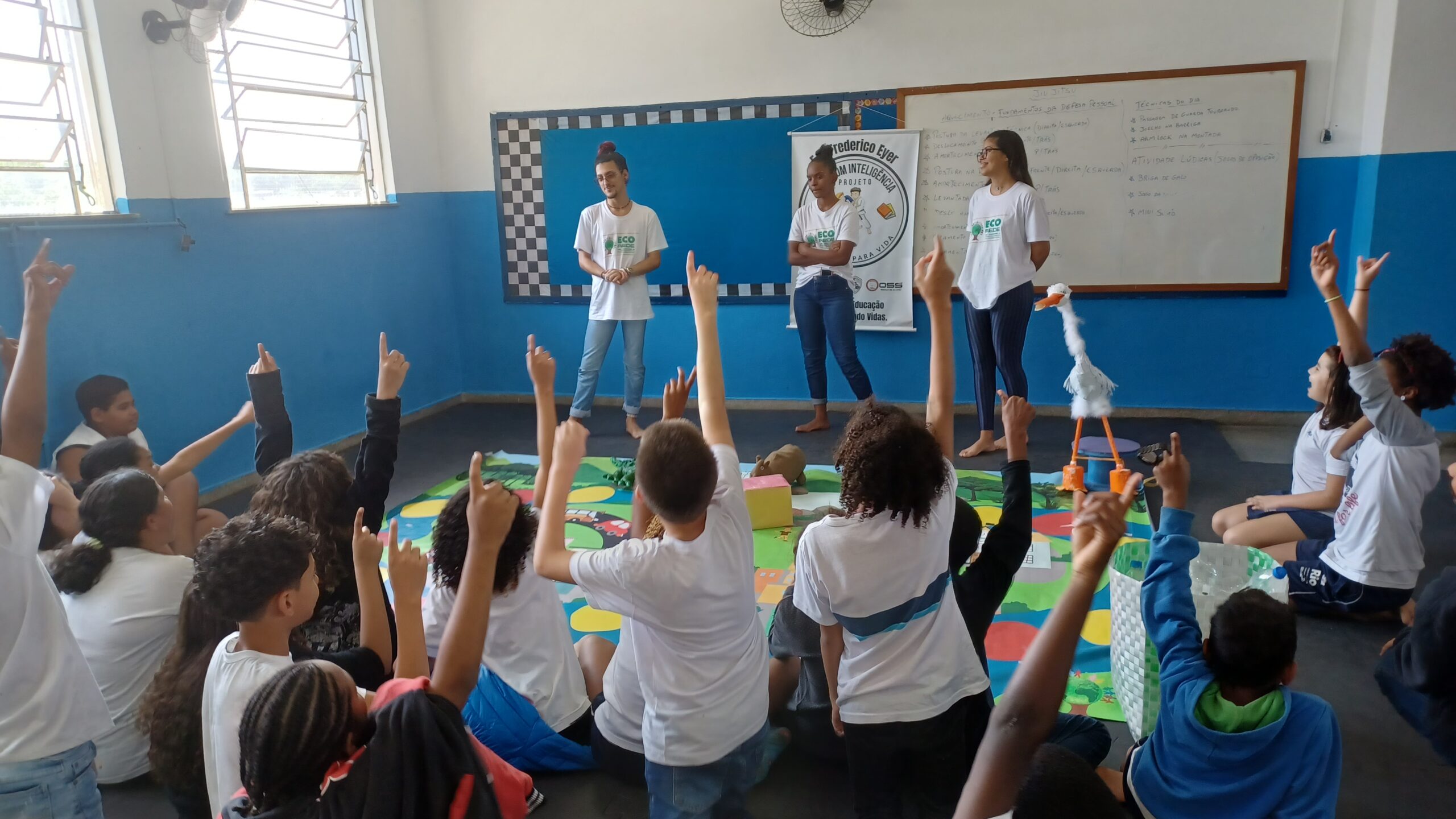
The gameplay involves cleaning rivers and disposing of solid waste at a recyclables collection point when students answer questions correctly. The game sheets contain information about the area’s environment, stories, and data that require collaboration from all students in the class. It serves as a moment of exchange with and among students, based on their own knowledge.
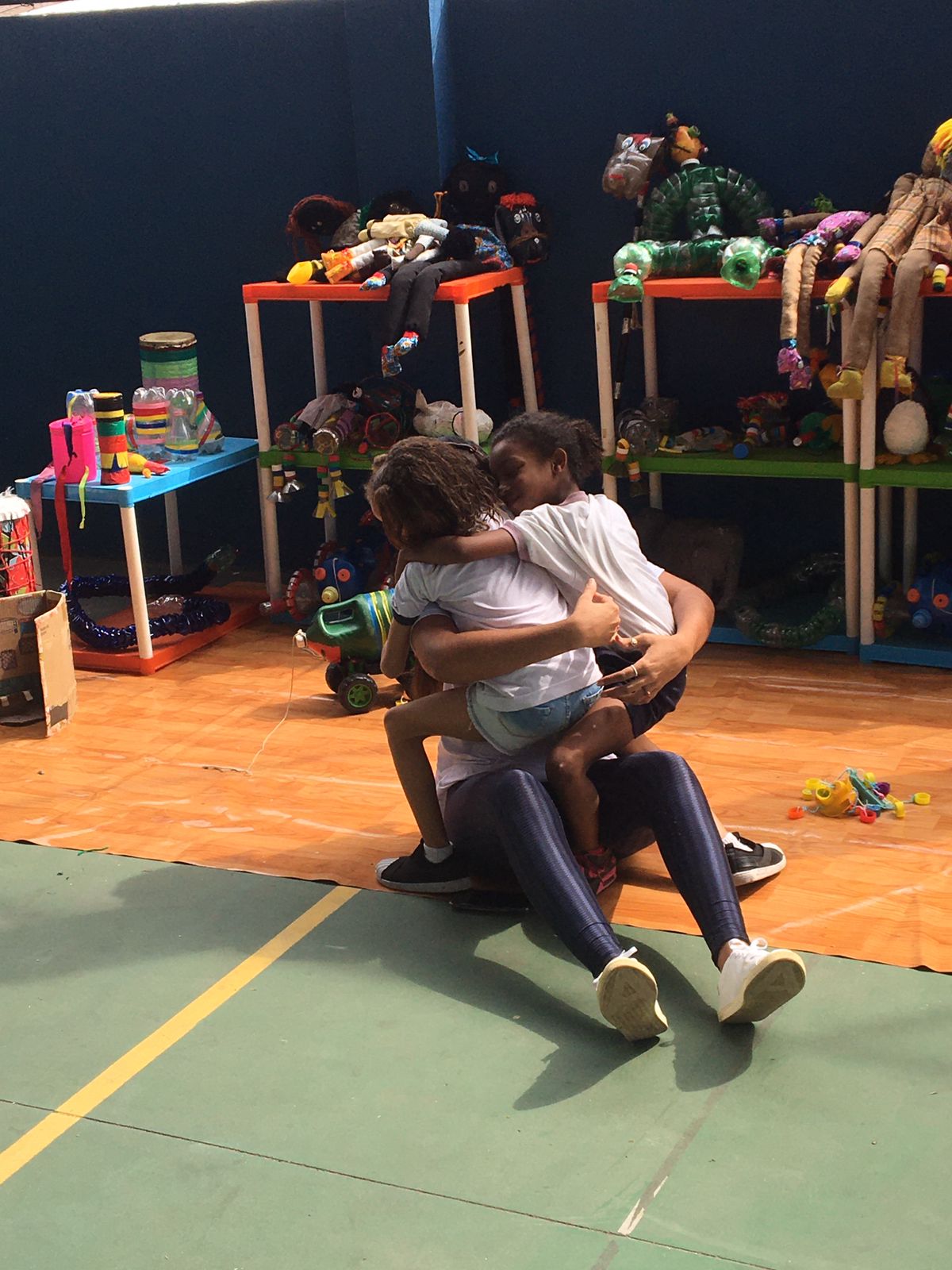
In short, Alfazendo, Eco Network and Meeting of the Waters address the beauty of recognizing oneself as Nature in the heart of City of God. They are about strengthening our identity as favela residents. The three—institution, project and generating theme—carry the mission of changing our vision, which normalizes the absurdity of the death of rivers, looking affectionately towards our territory’s waters.
About the authors:
Gabrielle da Conceição was born and raised in the Quinze area of City of God and has been part of Alfazendo for six years. As a member of the Eco Network project, she worked for five years as a socio-environmental education promotion agent and is currently serving as the pedagogical coordinator. In 2022, she was a youth researcher in the course Monitoring Water and Energy Justice in the Favelas.
Lidiane Santos likes to say, “I am Water.” Born in Esplanada, Bahia, she was raised by her grandmother Maria and her daughters. Dona Rose, her mother, has been a resident of City of God since 1996. Coordinator of the Eco Network project (Alfazendo/CDD) since 2015 and mother of Arthur, Santos is a biology teacher with an undergraduate degree from the Federal University of Rio de Janeiro (UFRJ). Currently pursuing a master’s degree in Ecotourism and Conservation (PPGEC/UNIRIO), her research involves “Escrevivendo the Conservation of the Natures of City of God: The Geopoetics of Moving Waters.”
*The Sustainable Favela Network (SFN) and RioOnWatch are initiatives of the NGO Catalytic Communities (CatComm).

